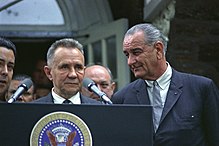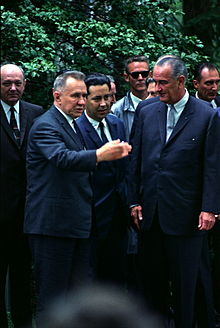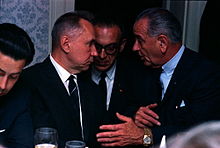Glassboro Conference
The Glassboro Summit Conference ( English Glassboro Summit Conference ) was a top-level meeting between the Soviet Prime Minister Alexei Kosygin and US President Lyndon B. Johnson that between 23 and 25 June 1967 in the town of Glassboro in the State of New Jersey took place. The conference aroused great interest from the global public.
History and preparations
As a result of the Six Day War , the Soviet Prime Minister Alexei Kosygin traveled to the United Nations in New York City in June 1967 . The then American President Lyndon B. Johnson wanted to use this opportunity to talk to the Soviet head of government about the current global political situation. The meeting was intended to help create a better and clearer understanding of the superpowers facing each other in the ideological conflict of the Cold War . Above all, it was about settling disagreements between the two countries in relation to various proxy wars that were in progress, and thus also avoiding a direct military conflict between the USSR and the USA , which with a certain probability could have meant a nuclear war .
On the part of President Johnson, the meeting would initially take place in Washington, DC . The American head of state initially wanted to invite Kosygin to an official visit to the White House . However, he saw too many difficulties, also with regard to his safety. Johnson then proposed a meeting at Camp David , the US president's country residence, not far from Washington. Kosygin announced that he would prefer the summit to take place in New York, as he also saw safety risks with regard to the longer journey by car. Johnson, however, saw Kossygin's proposal as too problematic in terms of security. However, since both men were interested in a conference, it was finally possible to agree on the rather rural town of Glassboro in the state of New Jersey , which is roughly between New York and Washington.
Content of the conference
On June 23, 1967, the meeting began with the arrival of the two statesmen at a country house called Hollybush . The preparations in Glassboro itself were made in the shortest possible time due to the fact that the meeting was held at short notice. In addition to a number of security guards, numerous reporters and media representatives had arrived. The interest of the population was also extremely high. In addition to Johnson and Kosygin themselves, other high-ranking politicians from both countries were also present, such as US Secretary of State Dean Rusk , US Secretary of Defense Robert McNamara and Soviet Foreign Minister Andrei Gromyko . The wives and daughters of both leaders were also present. Johnson and Kosygin mainly talked about the Six Day War that took place in the same month and the general security situation in the Middle East . The President assured the Soviets that the United States would refrain from any use of force in the Middle East, but that the security of Israel was of great US interest. Kosygin replied that while the Soviet Union did not want war, it would honor its commitments to its allies (such as Syria ). Both agreed, however, to want to work towards a peaceful atmosphere in the Orient. However, no concrete measures and resolutions were adopted. Another important topic of conversation was the Vietnam War , which has been going on for several years ; The United States provided direct military aid to its ally South Vietnam , which was fighting against the communist north, which was allied with Moscow and which received mainly war material and military advisers from the USSR. Although both heads of government made their positions clear, Johnson asked Kosygin to mediate between the United States and its Soviet ally, North Vietnam , which the Prime Minister accepted. He assured Johnson of his help in this regard, but made it clear that he could not force Hanoi to act. He recommended the US head of state to at least temporarily stop the massive air strikes in order to document his real interest in peace negotiations. Johnson replied that such attempts had already been made several times and that the bombing was stopped militarily by the enemy. Nevertheless, the president declared himself ready to accept Kosygin's request, whereupon the latter made clear his support for the negotiations.
The topic of disarmament was also particularly important at the conference. Johnson in particular urged ratification of the Non-Proliferation Treaty in order to reduce the risk of a nuclear confrontation; especially with regard to states that did not yet have nuclear weapons. Kosygin agreed to this and also agreed to extensive relations with Washington, but he was not solely authorized by the Soviet government to decide this. The Nuclear Non-Proliferation Treaty was actually signed a little more than a year later in July 1968. In the area of missile defense systems, in which both superpowers were fighting a strong race for the best nuclear missile defense system, no final solution could be found. President Johnson initially called for this costly competitive struggle to be halted, but later declined - when the Soviets continued the program - that it should be halted.
Reactions
The Glassboro conference, which ended on June 25, was described as a success by the media and the general public. President Johnson's polls in America rose significantly after the meeting. Kosygin was surprised at the many US citizens who had gathered around the Hollybush house and greeted him with great joy and concern. Johnson was also surprised; in his memoirs he later wrote that he had expected security risks and anti-Soviet demonstrations.
literature
- William Conrad Gibbons : The US Government and the Vietnam War: Executive and Legislative Roles and Relationships, Part IV: July 1965-January 1968. Princeton University Press 1995. ISBN 0-691-00635-0 .
- Lyndon B. Johnson: My years in the White House . Präger Verlag, ISBN 3-7796-8020-3 , pp. 364-390.
Web links
- Lyndon B. Johnson's World in Die Zeit , July 21, 1967




